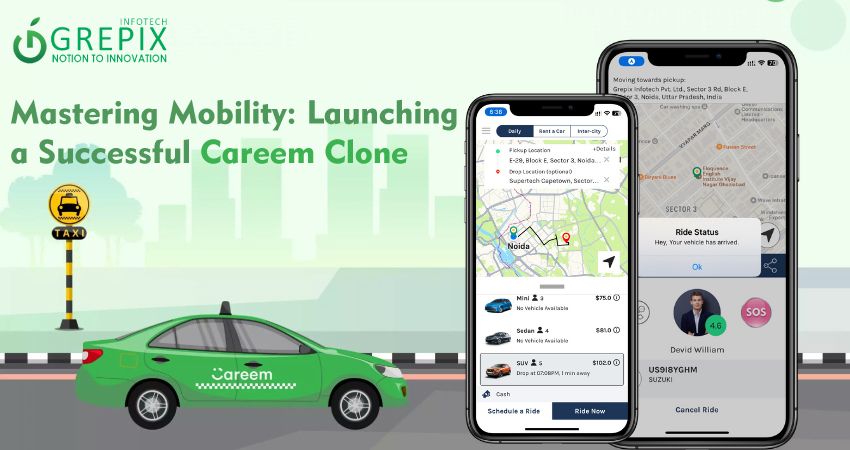Mastering Mobility: Launching a Successful Careem Clone
In the ever-evolving world of urban transportation, the success of ride-sharing companies such as Careem has revolutionized how people commute in the Middle East and North Africa (MENA). For any taxi app development company aiming to capture a slice of this lucrative market, creating a successful Careem clone could be a golden opportunity. This comprehensive guide aims to walk you through the steps and strategies necessary to launch a standout ride-sharing app in today's competitive landscape.
This comprehensive guide explores the development and launch of a successful Careem clone, emphasizing the importance of understanding the unique needs and dynamics of the MENA region's ride-sharing market. It covers the essentials of creating a user-friendly app with robust features such as multiple payment options, advanced safety tools, and dynamic pricing. The guide also highlights the significance of scalable technology infrastructure, strategic marketing, and navigating regulatory landscapes. By leveraging local partnerships and continuously iterating based on user feedback, businesses can build a strong brand presence and adapt to the competitive and regulatory challenges of the urban mobility market.
Introduction to the Ride-Sharing Landscape
The ride-sharing industry has grown from a niche market to a cornerstone of urban mobility, offering convenient, affordable, and efficient transportation alternatives to traditional taxis and public transit. Companies like Careem clone have not only adapted to the unique demands and regulatory environments of the MENA region but have also pioneered innovative solutions that resonate with local users.
Market Research: Understanding User Needs and Regional Dynamics
Successful app development starts with thorough market research. Understanding the specific needs of your target audience in the MENA region is crucial. This involves analyzing commuting patterns, payment preferences, safety concerns, and the unique socio-economic factors influencing user behavior. Additionally, studying competitors’ strengths and weaknesses will help you identify gaps in the market and areas for innovation.
Designing the App: User Experience (UX) and Interface (UI)
The usability of your app plays a critical role in its success. A well-designed interface (UI) should be visually appealing and intuitive, allowing users to navigate the app effortlessly. The user experience (UX) should focus on minimizing the time and steps required to book a ride. This can be achieved through features like quick re-booking, customizable ride options, and real-time tracking.
Robust Features for a Competitive Edge
To stand out in the MENA market, your Careem clone must offer unique features that address local needs. Consider including multiple payment options, including cash, credit cards, and popular local e-wallets, to cater to all user segments. Real-time language translation can enhance communication between drivers and passengers, improving service quality. Other features might include:
- Advanced Safety Features: Emergency buttons, ride tracking, and driver background checks are critical in ensuring passenger and driver safety.
- Dynamic Pricing Tools: Implementing algorithms that adjust prices based on traffic patterns, demand spikes, and other real-time factors can optimize earnings and service availability.
- Loyalty Programs: Encouraging repeat business through discounts, ride credits, and tiered rewards can foster a loyal customer base.
Leveraging Local Partnerships and Integrations
Leveraging local partnerships and integrations is a strategic approach that can significantly enhance the value and reach of SAAS-based taxi apps. By collaborating with local businesses, city planners, and public transportation agencies, these platforms can tailor their services to meet the unique needs of each community. For instance, integrating with local traffic management systems can improve route optimization, reducing delays and increasing customer satisfaction.
Partnerships with restaurants and entertainment venues could offer users promotions or integrated service packages, enhancing the overall user experience. Furthermore, working closely with municipal governments can ensure that the app complies with local regulations and contributes positively to the city's transportation ecosystem. These collaborative efforts not only improve the service offered by the taxi apps but also help cement their role as integral components of urban mobility.
Also Read: "Comprehensive Guide: How To Starting Your Business In USA"
Scalable Technology Infrastructure
Scalable technology infrastructure is crucial for SAAS-based taxi app to efficiently manage varying demands and expand their services. A robust infrastructure underpins the app's ability to scale up or down seamlessly without compromising performance during peak traffic times or in densely populated urban areas. This involves utilizing cloud computing platforms that provide flexibility and scalability while minimizing downtime and latency. By adopting microservices architecture, these apps can ensure that different components of the service can be independently scaled and updated, which enhances overall system resilience and agility.
Additionally, implementing advanced data storage solutions and real-time data processing capabilities allows for the efficient handling of large volumes of user data and transactional information, ensuring that the app can grow with its user base and geographic expansion. This scalable infrastructure not only supports current operational needs but also lays the groundwork for future innovations and integrations, maintaining the app’s competitiveness and relevance in the fast-evolving urban mobility landscape.
Marketing Strategy: Building Brand Presence
Developing a robust marketing strategy is essential for building brand presence and distinguishing a SAAS-based taxi app in a competitive market. This strategy should focus on creating a strong, recognizable brand that resonates with target demographics through multiple channels. Utilizing social media platforms effectively can enhance visibility and engage users with compelling content and real-time updates. Influencer partnerships can also amplify reach and lend credibility to the brand.
Additionally, targeted advertising campaigns using SEO and location-based marketing can attract users who are most likely to benefit from the service. Offline marketing efforts, such as participating in local events and creating partnerships with businesses and tourism boards, can further reinforce the brand’s presence in the community. This multi-channel approach ensures that the marketing message is consistent and pervasive, establishing the app as a trusted, go-to choice for urban transportation needs.
Navigating Regulatory Hurdles
Navigating regulatory hurdles is a critical challenge for SAAS-based taxi apps, given the complex and often varying legal landscapes of different cities and countries. To successfully manage these obstacles, it is essential for companies to proactively engage with local government bodies and transport authorities to understand and influence policy-making. This involves regular communication and collaboration to ensure that the app complies with existing transport regulations, data protection laws, and safety standards.
Additionally, adopting a flexible approach to adapt features and operations in response to new regulations can help mitigate risks associated with non-compliance. Building a strong legal team that specializes in local and international transport laws can also provide the necessary guidance and foresight to navigate these regulatory waters effectively. By staying ahead of legal requirements and actively participating in the regulatory environment, taxi apps can secure their operations and foster a positive relationship with both regulators and the communities they serve.Launch and Iteration: Feedback-Driven Development
In the dynamic market of SAAS-based taxi apps, the process of launch and iteration is crucial for refining and optimizing the service based on user feedback. This feedback-driven development approach allows companies to continuously improve their product by integrating real-world insights into the app's design and functionality. After the initial launch, it’s important to establish mechanisms for collecting feedback, such as user surveys, in-app rating systems, and direct customer support channels.
This data should be systematically analyzed to identify common pain points and areas for enhancement. Regular updates should then be rolled out to address these issues, improve user experience, and introduce new features that meet evolving customer needs. Additionally, iterative testing of these updates in controlled environments or via beta releases can help fine-tune the app before a full-scale rollout. This iterative process not only enhances the product but also signals to users that their input is valued, fostering a loyal user base and improving customer satisfaction.
Conclusion
In conclusion, launching a successful Careem clone involves a multifaceted approach that encompasses understanding the market, leveraging advanced SAAS-based technology, and continuously iterating based on user feedback. Key to this endeavor is building a scalable technology infrastructure that can adapt to changing demands and expanding markets. Marketing strategies must be adept at building a strong brand presence both online and offline, ensuring that the service stands out in a crowded marketplace.
Furthermore, navigating regulatory hurdles with proactive engagement and compliance is crucial for smooth operations and sustainable growth. By focusing on these strategic areas, businesses can not only launch but also thrive in the competitive arena of urban mobility, ultimately mastering the art of delivering seamless, efficient, and customer-friendly transportation solutions. This comprehensive approach will not only meet current urban transportation needs but also adapt to future trends and challenges, leading the way in the evolution of global mobility services.







